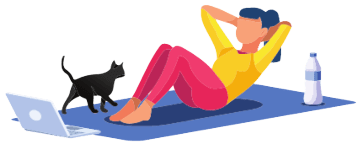Reconnecting with Your Body
Over the last year, I’ve noticed a recurring theme emerge when someone new reaches out to my studio. A recent caller shared that in the last two years she’d lost a valuable connection; “I’ve not exercised in two years,” her voice a combination of trepidation and disbelief. Another client told me, “My knees hurt now, and they never hurt before.” It’s my belief that the pandemic may have temporarily changed each of us, creating less body connection, less embodiment.
Overall, the emerging theme is disconnection. It may be a disconnection from movement, or from feeling, or from relaxation. The desire underneath, always, is for the connection to return.
For someone who has been somewhat sedentary, or stressed, or even just too reluctant to slow down, it’s good to begin with exercises for reconnecting with the physical body. There are hundreds of ways to start, but the easiest, most profound is to introduce techniques that place extra attention on the breath and the posture.
Remember, consideration and thoughtfulness toward breath quiets the mind by dialing up the parasympathetic nervous system. And a return to how to breathe involves deeper concentration, and ultimately, requires connecting with the muscles most involved in breathing. The diaphragm, one of the deep intrinsic stabilizing muscles of the torso, is the muscle used in breathing. Another intrinsic stabilizing muscle in the torso is the transversus abdominus (TVA). Engaging this deep abdominal muscle always improves posture.
A favorite combination I teach is a practice of lengthening the spine while placing voluntary attention to the breath, creating a powerful healing connection. And once mastered, it’s easy to do anytime.
Standing breathwork for reconnecting with your body:
This exercise is best performed standing. You’ll need two adjustable hiking poles set to about 48 inches. Or make a set with a pair of 1 inch x 48-inch wooden dowels.

Stand with your feet under your hips, one stick in each hand. Place your hands, palm-down, directly on top of each stick, allowing your fingers to lengthen and relax. The sticks should be perpendicular to the floor and held at arms-length. Next, straighten your arms, and press downward more firmly into the sticks. As you press, listen and feel, notice what’s going on in your body, specifically around and through your belly, your sides, under your arms.
Did you notice how your ribcage lifted upward and away from your waistband when you pushed downward on the sticks? This easy move enhances good posture. Feel the difference in your spine? Practice it again.
Now, place attention at the breath. While keeping your arms long, the sticks upright and your chest lifted, draw-in your belly-button. This cue creates awareness and thus strengthens the deepest of the abdominal muscles, the TVA. Once the TVA is drawn-in, keep it drawn-in.
Still pressing your palms into the sticks, slowly inhale through your nose, expanding your ribcage. Once again, don’t let your TVA slacken (remember this is the muscle you engaged by drawing-in your belly button). Once your ribs are fully expanded, exhale through pursed lips making the sshhh sound as you go.
Notice what happened next? Making the sshhh sound produced more tightness in your abdomen—specifically the TVA muscle. The ab muscle grew tauter. Try this again! Take another deep, expanding breath, allowing the ribs to open. Don’t forget to keep the belly tucked in. Then exhale.
The deep inhalations and slow exhalations work the diaphragm, another of the deep intrinsic stabilizing muscles of the torso. While practicing, keep attention at the arms, the chest, the belly, and the breath.
Start this daily exercise with 6-8 smooth, slow breaths. Each time pay attention to how the torso responds to the effort. Build-up to doing this technique for 4-5 minutes each day.
Dedicating time to performing this each day can reconnect you with your body in ways that may surprise and delight.
- Alignment
- Balance Training
- Baseline Measures
- Behavior Change
- Better Sex
- Blood Pressure
- Bone Health
- Bones
- Cardiopulmonary Health
- Cardiovascular Health
- Chronic Inflammation
- Corrective Exercise
- Diabesity
- Diabetes
- Enhancing Sleep
- Exercise
- Exercise as Medicine
- Exercises for Scoliosis
- Fitness
- Fitness Testing
- Flying
- Foam Rolling
- Functional Exercise
- Goal Setting
- Heart and Lung Health
- High Intensity Interval Training
- HIIT
- Improve Cognitive Function
- Improving Range of Motion
- Joint Stability
- Maintaining Healthy Weight
- Metabolic Health
- Mood Enhancer
- Muscle Soreness
- Obesity
- Online Training
- Osteoporosis
- Posture
- Reducing Muscle Soreness
- Resistance Training
- Schroth Method
- Scoliosis
- Strength Training
- Structural Integration
- Structural Integration
- Traveling
- Tuning the Body for Travel
- Uncategorized
- Vitality
- Walking

Thanks for your blog, nice to read. Do not stop.
Thanks for reading, and for your encouragement. In reading, I hope you found the information useful.